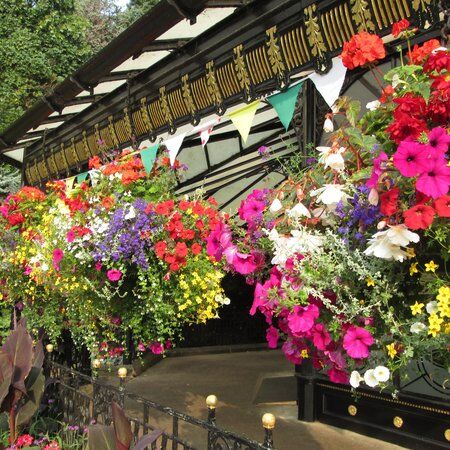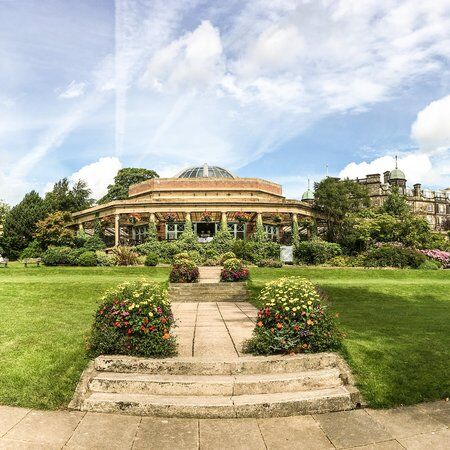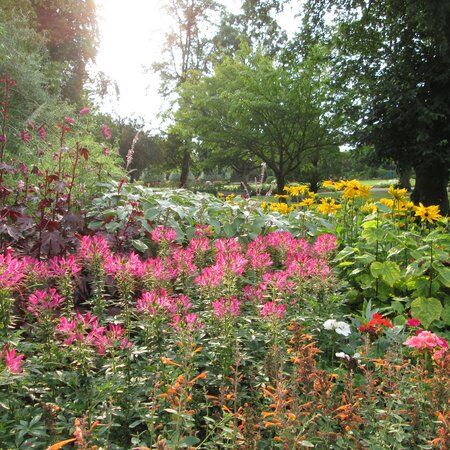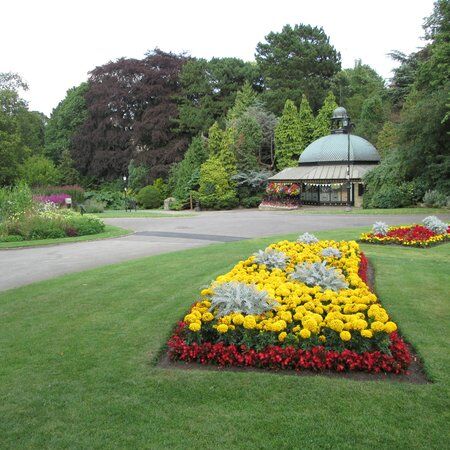
Discover Valley Gardens
Valley Gardens is an English Heritage Grade II-Listed garden in Low Harrogate, North Yorkshire. Combined with The Pinewoods, the gardens span 17 acres and are teeming with vibrant flora, historic architecture, mineral springs, and lush greenery. Some of the historic buildings include the Magnesia Well Pump Rooms, the Sun Pavilion, and the Sun Colonnade. These buildings are actively preserved by the North Yorkshire Council and Friends of Valley Gardens (FOVG), but part of the gardens themselves are also protected.
“Upon a high ground, a short distance from Low Harrogate, in a westerly direction, is a piece of moss or bog earth.....The whole surface there, to a considerable extent, presents an extraordinary phenomenon in the physical history of the place. Deep sulphur wells, two or three pools of water impregnated with tannin and more than one saline chalybeate.....which altogether has the appearance of a great chemical laboratory of nature.”
Under the Harrogate Borough Council Act 1986, the protected land known as Bogs Field has 36 different mineral wells; more so than any other known place and each distinctively unique.

Valley Garden’s Rich History
“I drank a quart in the morning for two days and hold them to be a good sort of Purge if you can hold your breath so as to drink them down."
After the discovery of Harrogate’s first mineral springs in the 16th century, visitors were drawn to the area in search of natural beauty and wellness – a luxury afforded them by ‘taking the waters’, which literally meant drinking the spring water. They would tread the footpath from the town to Bogs Field – named such due to the marshy quality created by the springs. In order to accommodate these health fanatics, residential homes were transformed into guest houses and the Harrogate Improvement Commissioners sanctioned the creation of Valley Gardens; to add a touch of flair along the walk from taking the waters to the town.
By this point, Harrogate’s reputation as a spa destination was well established and a routine regime was also adhered to. Visitors would arrive between 7am and 9am and drink one or more glasses then walk through the gardens before the second ‘taking’. In light of this Valley Gardens, which over the years had become a fully landscaped garden, quickly became a place for socialising, exercise, and simply promenading. The popularity of the former humble flowerbed and tree lined waterside walkway is supported by photographs from the early 20th century, which depicts crowding at the tea room, boating lake, and bandstand.

Victorian Elegance at the Valley Gardens
The Victorian era left an indelible mark on Valley Gardens. The gardens showcase the era's penchant for ornate design and meticulous landscaping. Meandering through the gardens, visitors can marvel at beautifully crafted features like the Sun Pavilion, which harks back to the opulent architecture of the late 19th century. The Sun Colonnade, a series of elegant pillars and arches, offer a stunning backdrop for leisurely strolls and photography. However, both structures would have been lost in the 1990s, if it had not been for the loving restorations conducted by FOVG.
The first building in the gardens was actually erected in 1858, when the Improvement Commissioners wanted a pump room for the mineral springs. In a distinctive Gothic style that was typical of the time the building, which was restored by FOVG in 2015, is now used as a museum and place of education. After the success of the first pump house, a second, larger building was established in 1895, which turned out to be one of the prettiest spas of Victorian England. Today, it is home to a popular café.

Developing Valley Gardens
World War One
Much of Valley Gardens development occurred after the First World War. Despite there being a widespread decline in the number of people attending spas across the country, Harrogate’s numbers had actually increased. Because of this the council decided to invest in amenities for its visitors; tennis courts, toilets, a children’s boating pool, a Japanese Garden, and flower beds surrounding Bogs Field were all added.
World War Two
During the Second World War, iron railings and lamps were salvaged and some of the ornamental beds were used for vegetable production as part of the war effort. But after 1945, plans were undertaken again to embellish Valley Gardens. A putting green was made from two former tennis courts, children’s playground facilities were installed, and a collection of rare trees and other plants were installed. This included New Zealand species gifted by the City of Wellington in 1953, which inspired the creation of the New Zealand Garden. After several more specimens were donated, the New Zealand Garden grew to hold 60 different species.
Recent Developments
In 1963, Harrogate began to participate in Britain in Bloom. An affair that soon outgrew the Valley Gardens and was moved to the Yorkshire Show Ground in the 1980s. This was also around the time that the original FOVG was set up – to ensure the preservation of the gardens. As for the mineral springs they could not be preserved; the well heads were vandalised in the 1970s and so it was decided to cap the wells and bury them. But although the original purpose of the gardens has been lost in time, a trip to Valley Gardens remains an incredibly relaxing experience.

The Wonderland that is Valley Gardens
Horticultural Delights
One of Valley Gardens' most impressive attributes is its stunning collection of horticultural specimens. Home to an array of flowerbeds, shrubs, and trees the gardens are a spectrum of colour. Whether wandering through the Japanese Garden, the New Zealand Garden, or perusing the dainty flower beds dotted around, visitors will experience a sensory overload at this vibrant spot in Harrogate.
And the appeal of Valley Gardens is not confined to a single season either. Each visit yields new discoveries, as the gardens change with the weather. Spring offers a spectacle of crisp yellow daffodils, while summer provides a riotous backdrop of roses and dahlias on those lazy, picnic-vibey, sunny afternoons. Autumn manifests as a canvas splashed with rich golden, reddy-brown hues and even in winter, Valley Gardens maintain their charm, with frosted foliage and peaceful tranquillity. By the sheer diversity of the landscape, there's always a reason to visit Valley Gardens!
Water Features and Wildlife
Valley Gardens is punctuated by several picturesque water features. This includes the ornamental lakes, with their graceful swans and playful ducks. The scents and sounds of nature abound, making the gardens a haven for wildlife enthusiasts. Keen observers might spot a variety of bird species, from herons to kingfishers, as well as playful squirrels and other small mammals.
Year-Round Delights
As well as the natural qualities of the gardens, the space also provides for community engagement with its tennis courts, crazy golf, and skate park. Furthermore, the gardens play host to a variety of events and festivals throughout the year. These outdoor productions attract a lot of families, and young people from Harrogate, bringing the local community together in a fun and safe atmosphere. From theatre productions and music festivals, to horticultural exhibitions and educational workshops; visiting Valley Gardens is a great way to spend an afternoon.

Our Thoughts…
As you explore Valley Gardens – fragrant flower beds, thoughtful amenities, Victorian architecture, and all – you'll find they remain true to their spa themed past where nature, history, and community converge to create a lasting sense of wonder and relaxation.
Interested in finding more places like this? Try one of our Treasure Trails in York - untangle cryptic clues as a team, as you are taken on a journey to the most unique, unusual and bizarre corners of York.














